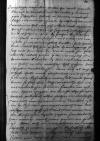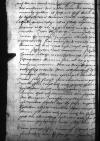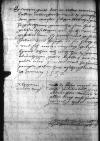Das cf. Ioannes DANTISCUS to Johann Albrecht of Brandenburg-Ansbach 1531-12-21, CIDTC IDL 7381, letter lost⌊erstcf. Ioannes DANTISCUS to Johann Albrecht of Brandenburg-Ansbach 1531-12-21, CIDTC IDL 7381, letter lost⌋ 21 Decembris und das cf. Ioannes DANTISCUS to Johann Albrecht of Brandenburg-Ansbach 1532-01-03, CIDTC IDL 7382, letter lost⌊anderecf. Ioannes DANTISCUS to Johann Albrecht of Brandenburg-Ansbach 1532-01-03, CIDTC IDL 7382, letter lost⌋ 3. Ianuarii peyte schreyben hab ich 20 Ianuarii empfangen. Selcher nit wenig erfreudt, dy weyl ich daraus vernomen hab, euer gesundhadt und meiner brieff uberantbortung say euch erstlich grossen danck gehabptens vleys die sachen, Charles V of Habsburg (*1500 – †1558), ruler of the Burgundian territories (1506-1555), King of Spain as Charles I (1516-1556), King of Naples and Sicily, King of the Romans (1519-1530), Holy Roman Emperor of the German Nation (elected 1519, crowned 1530, abdicated 1556); son of Philip I the Handsome and Joanna the Mad of Castile⌊keyserlicher maiestadtCharles V of Habsburg (*1500 – †1558), ruler of the Burgundian territories (1506-1555), King of Spain as Charles I (1516-1556), King of Naples and Sicily, King of the Romans (1519-1530), Holy Roman Emperor of the German Nation (elected 1519, crowned 1530, abdicated 1556); son of Philip I the Handsome and Joanna the Mad of Castile⌋ anzuczeygen. / Und nach Charles V of Habsburg (*1500 – †1558), ruler of the Burgundian territories (1506-1555), King of Spain as Charles I (1516-1556), King of Naples and Sicily, King of the Romans (1519-1530), Holy Roman Emperor of the German Nation (elected 1519, crowned 1530, abdicated 1556); son of Philip I the Handsome and Joanna the Mad of Castile⌊irer maiestadtCharles V of Habsburg (*1500 – †1558), ruler of the Burgundian territories (1506-1555), King of Spain as Charles I (1516-1556), King of Naples and Sicily, King of the Romans (1519-1530), Holy Roman Emperor of the German Nation (elected 1519, crowned 1530, abdicated 1556); son of Philip I the Handsome and Joanna the Mad of Castile⌋ so undertheniglich bevellen stedt zuverdinen, / und hab gern gehordt, dy anczeygung so sich mit dem orten zu Tournai (Tornacum, Doornik), city in the Habsburg Netherlands, ca. 80 km SW of Brussels, on the Schelde (Scheldt) river, centre of the territory of Tournai and the Tournaisis, which was incorporated into the Habsburg Netherlands in 1521; now in the Belgian province of Hainaut⌊TornaiTournai (Tornacum, Doornik), city in the Habsburg Netherlands, ca. 80 km SW of Brussels, on the Schelde (Scheldt) river, centre of the territory of Tournai and the Tournaisis, which was incorporated into the Habsburg Netherlands in 1521; now in the Belgian province of Hainaut⌋ verlassen hadt. Elandt etlich person, so des nit wyrdig sein, darinnen benendt, / dy dan wol etbas anderes am haltz tragen mocht(en). /
Hab pyshere das schreyben underlassen, dan ich al tag gehofft hedt, euch personlich anczusprechan, so ir mit Charles V of Habsburg (*1500 – †1558), ruler of the Burgundian territories (1506-1555), King of Spain as Charles I (1516-1556), King of Naples and Sicily, King of the Romans (1519-1530), Holy Roman Emperor of the German Nation (elected 1519, crowned 1530, abdicated 1556); son of Philip I the Handsome and Joanna the Mad of Castile⌊keyserlicher maiestadtCharles V of Habsburg (*1500 – †1558), ruler of the Burgundian territories (1506-1555), King of Spain as Charles I (1516-1556), King of Naples and Sicily, King of the Romans (1519-1530), Holy Roman Emperor of the German Nation (elected 1519, crowned 1530, abdicated 1556); son of Philip I the Handsome and Joanna the Mad of Castile⌋ werdt herauf komen. / So sich aber seliche verczeucht, hab ich nit underlassen kun(n)en, sunder ein eygnen dyner, czeyger dis brieffs, abzufertigen, dann ir gebisslich aller sachen im entschafft von euch mocht vernemen. / Nemlich ist, das dy erst und principal ursach, was das geschra am hoff ist und was man von den Albrecht of Brandenburg (Albrecht von Hohenzollern) (*1490 – †1545), 1499-1545 co-Margrave of Brandenburg (together with his brother Joachim I Nestor), 1513-1545 Archbishop of Magdeburg, 1514-1545 Elector and Archbishop of Mayence, 1518 elevated to cardinal; son of Johann Cicero, Prince-Elector of Brandenburg, and Margarete of Saxony (daughter of Wilhelm III von Sachsen)⌊kurfurstenAlbrecht of Brandenburg (Albrecht von Hohenzollern) (*1490 – †1545), 1499-1545 co-Margrave of Brandenburg (together with his brother Joachim I Nestor), 1513-1545 Archbishop of Magdeburg, 1514-1545 Elector and Archbishop of Mayence, 1518 elevated to cardinal; son of Johann Cicero, Prince-Elector of Brandenburg, and Margarete of Saxony (daughter of Wilhelm III von Sachsen)⌋ thudt sagen, sunderlich von Meintz. Auch was Bavaria (Bayern), duchy in southeastern Germany⌊PeyernBavaria (Bayern), duchy in southeastern Germany⌋ im spil ist. / Dan ich in einer geham ein mappa mundi, so mitten in eyne(n) keyserliche(n) adler stedt mit zweyen wappen auf itzlicher seyten, eins meins Albrecht of Brandenburg (Albrecht von Hohenzollern) (*1490 – †1545), 1499-1545 co-Margrave of Brandenburg (together with his brother Joachim I Nestor), 1513-1545 Archbishop of Magdeburg, 1514-1545 Elector and Archbishop of Mayence, 1518 elevated to cardinal; son of Johann Cicero, Prince-Elector of Brandenburg, and Margarete of Saxony (daughter of Wilhelm III von Sachsen)⌊hern von MeintzAlbrecht of Brandenburg (Albrecht von Hohenzollern) (*1490 – †1545), 1499-1545 co-Margrave of Brandenburg (together with his brother Joachim I Nestor), 1513-1545 Archbishop of Magdeburg, 1514-1545 Elector and Archbishop of Mayence, 1518 elevated to cardinal; son of Johann Cicero, Prince-Elector of Brandenburg, and Margarete of Saxony (daughter of Wilhelm III von Sachsen)⌋  AAWO, AB, D.132, f. 41v auf der ein und probably Johann of Brandenburg-Küstrin (Hans von Küstrin) (*1513 – †1571), 1535-1571 Margrave of Brandenburg-Küstrin⌊marggraff Jochannesprobably Johann of Brandenburg-Küstrin (Hans von Küstrin) (*1513 – †1571), 1535-1571 Margrave of Brandenburg-Küstrin⌋ auf der andern, den adler mit der mappa hidden by binding⌈[a]a hidden by binding⌉ mundi halden. / Ab selche an hoff kom(m)e bevor hidden by binding⌈[vor]vor hidden by binding⌉ dy distributiones darvon wolt ich gern [...] hidden by binding⌈[...][...] hidden by binding⌉ thudt gutten vleys, ab ir selche erfaren m[...] hidden by binding⌈[...][...] hidden by binding⌉ damit ichs in eygentlich mocht be[...] hidden by binding⌈[...][...] hidden by binding⌉ werden. / Von Charles V of Habsburg (*1500 – †1558), ruler of the Burgundian territories (1506-1555), King of Spain as Charles I (1516-1556), King of Naples and Sicily, King of the Romans (1519-1530), Holy Roman Emperor of the German Nation (elected 1519, crowned 1530, abdicated 1556); son of Philip I the Handsome and Joanna the Mad of Castile⌊keyserlicher maiestadtCharles V of Habsburg (*1500 – †1558), ruler of the Burgundian territories (1506-1555), King of Spain as Charles I (1516-1556), King of Naples and Sicily, King of the Romans (1519-1530), Holy Roman Emperor of the German Nation (elected 1519, crowned 1530, abdicated 1556); son of Philip I the Handsome and Joanna the Mad of Castile⌋ w[...] hidden by binding⌈[...][...] hidden by binding⌉ man hy nicht zu sagen elandt idern vermandt sein maiestadt werdt nicht hidden by binding⌈[ht]ht hidden by binding⌉ komen, ab das war ist, / wyl ich aus irem schreyben wol vernemen. / Schicke hidden by binding⌈[e]e hidden by binding⌉ hymit etliche neue czeytung, so vom The Swiss ⌊schweytzernThe Swiss ⌋ komen sein. Ab dy pey euch hidden by binding⌈[h]h hidden by binding⌉ noch nit weren, das ir derselbigen a[...] hidden by binding⌈[...][...] hidden by binding⌉ talhafftig werdt, dan ich verhoff, dy [...] hidden by binding⌈[...][...] hidden by binding⌉ teutschen sellen ein exempel darab [...] hidden by binding⌈[...][...] hidden by binding⌉ was sich sunst fur neue mere pey [...] hidden by binding⌈[...][...] hidden by binding⌉ verlassen, wyl ich euch gepet(en) haben, [...] hidden by binding⌈[...][...] hidden by binding⌉ dyselben auch anzuczeygen. /
AAWO, AB, D.132, f. 41v auf der ein und probably Johann of Brandenburg-Küstrin (Hans von Küstrin) (*1513 – †1571), 1535-1571 Margrave of Brandenburg-Küstrin⌊marggraff Jochannesprobably Johann of Brandenburg-Küstrin (Hans von Küstrin) (*1513 – †1571), 1535-1571 Margrave of Brandenburg-Küstrin⌋ auf der andern, den adler mit der mappa hidden by binding⌈[a]a hidden by binding⌉ mundi halden. / Ab selche an hoff kom(m)e bevor hidden by binding⌈[vor]vor hidden by binding⌉ dy distributiones darvon wolt ich gern [...] hidden by binding⌈[...][...] hidden by binding⌉ thudt gutten vleys, ab ir selche erfaren m[...] hidden by binding⌈[...][...] hidden by binding⌉ damit ichs in eygentlich mocht be[...] hidden by binding⌈[...][...] hidden by binding⌉ werden. / Von Charles V of Habsburg (*1500 – †1558), ruler of the Burgundian territories (1506-1555), King of Spain as Charles I (1516-1556), King of Naples and Sicily, King of the Romans (1519-1530), Holy Roman Emperor of the German Nation (elected 1519, crowned 1530, abdicated 1556); son of Philip I the Handsome and Joanna the Mad of Castile⌊keyserlicher maiestadtCharles V of Habsburg (*1500 – †1558), ruler of the Burgundian territories (1506-1555), King of Spain as Charles I (1516-1556), King of Naples and Sicily, King of the Romans (1519-1530), Holy Roman Emperor of the German Nation (elected 1519, crowned 1530, abdicated 1556); son of Philip I the Handsome and Joanna the Mad of Castile⌋ w[...] hidden by binding⌈[...][...] hidden by binding⌉ man hy nicht zu sagen elandt idern vermandt sein maiestadt werdt nicht hidden by binding⌈[ht]ht hidden by binding⌉ komen, ab das war ist, / wyl ich aus irem schreyben wol vernemen. / Schicke hidden by binding⌈[e]e hidden by binding⌉ hymit etliche neue czeytung, so vom The Swiss ⌊schweytzernThe Swiss ⌋ komen sein. Ab dy pey euch hidden by binding⌈[h]h hidden by binding⌉ noch nit weren, das ir derselbigen a[...] hidden by binding⌈[...][...] hidden by binding⌉ talhafftig werdt, dan ich verhoff, dy [...] hidden by binding⌈[...][...] hidden by binding⌉ teutschen sellen ein exempel darab [...] hidden by binding⌈[...][...] hidden by binding⌉ was sich sunst fur neue mere pey [...] hidden by binding⌈[...][...] hidden by binding⌉ verlassen, wyl ich euch gepet(en) haben, [...] hidden by binding⌈[...][...] hidden by binding⌉ dyselben auch anzuczeygen. /
Mit trau[...] hidden by binding⌈[...][...] hidden by binding⌉ hertzen hab ich vernome(n) den schaden, [...] hidden by binding⌈[...][...] hidden by binding⌉ der konigin junffra wyderfaren ist. Ist verbar schadt, das dy schen tugenth[...] hidden by binding⌈[...][...] hidden by binding⌉ hoheiten alsodt umb ir schens anges[...] hidden by binding⌈[...][...] hidden by binding⌉ komen sel. Aber ich pin noch der hofnung hidden by binding⌈[g]g hidden by binding⌉, Gott der almechtig sel irer artz seind[...] hidden by binding⌈[...][...] hidden by binding⌉ irs am geschicht nit schaden sel.
Vom portugesissen triumff schreyb ich n[...] hidden by binding⌈[...][...] hidden by binding⌉ sunderlich dan dysen gros fandastisch  AAWO, AB, D.132, f. 41r was dy potschaffter zu Passau (Batavia Bavariae), city in southern Germany, Bavaria, on the Danube river, 115 km SE of Regensburg⌊PassauPassau (Batavia Bavariae), city in southern Germany, Bavaria, on the Danube river, 115 km SE of Regensburg⌋ guth ausricht(en), wer mir liep das selbig zuversten. /
AAWO, AB, D.132, f. 41r was dy potschaffter zu Passau (Batavia Bavariae), city in southern Germany, Bavaria, on the Danube river, 115 km SE of Regensburg⌊PassauPassau (Batavia Bavariae), city in southern Germany, Bavaria, on the Danube river, 115 km SE of Regensburg⌋ guth ausricht(en), wer mir liep das selbig zuversten. /
Ich hor gern, so dy geselschafft zu euch kumbpt, das ir meiner so getreulich gedenckt. / Ich wyls warlich wyder verdinen und versult(en) und pyt euch, welledt sy al foer von meynetbegen grussen, / damit sy auch sehen, das ich ir wyder nit vergis. /
Euer cf. Ioannes DANTISCUS to Johann Albrecht of Brandenburg-Ansbach 1531-12-21, CIDTC IDL 7381, letter lost⌊erst schreybencf. Ioannes DANTISCUS to Johann Albrecht of Brandenburg-Ansbach 1531-12-21, CIDTC IDL 7381, letter lost⌋, so ir an mich gethan, ee ich wyder zw euch gen Brussels (Bruxellae), city in the Low Countries, Duchy of Brabant, since the regency of Mary of Hungary the capital of the Habsburg Netherlands, today the capital of Belgium⌊BrusselBrussels (Bruxellae), city in the Low Countries, Duchy of Brabant, since the regency of Mary of Hungary the capital of the Habsburg Netherlands, today the capital of Belgium⌋ kam, hab ich nach langem gehabpt(en) vleys uberkomen und darinnen befinden allen vleys, des ich dan ni kan vergessenn stellen wyl und sy erst das ich nicht ein gedechtnus hinder mir gelassen hab, das meiner darpey hedt mugen gedacht werden, / dan wor ich euch eines keysers schatz gegeben hedt, hedt ich solche gehabpte muhe nicht bezahlen mugen. / Aber wan wyr Gott der almechtig auch ein mal helffen wyrdt, so wyst ir wol, das mir ungethaldt sein. /
Hymit thue ich mich euch als meinem hochsten freundt und vatter pefollen. / Mit pyt, mich Charles V of Habsburg (*1500 – †1558), ruler of the Burgundian territories (1506-1555), King of Spain as Charles I (1516-1556), King of Naples and Sicily, King of the Romans (1519-1530), Holy Roman Emperor of the German Nation (elected 1519, crowned 1530, abdicated 1556); son of Philip I the Handsome and Joanna the Mad of Castile⌊keyserlicher maiestedtCharles V of Habsburg (*1500 – †1558), ruler of the Burgundian territories (1506-1555), King of Spain as Charles I (1516-1556), King of Naples and Sicily, King of the Romans (1519-1530), Holy Roman Emperor of the German Nation (elected 1519, crowned 1530, abdicated 1556); son of Philip I the Handsome and Joanna the Mad of Castile⌋ undertheniglich zubevehlen und mir zubissen thun, was ich erlangt hab in istis distributionib(us) Spain (Hispania)⌊HyspaniarumSpain (Hispania)⌋.
 AAWO, AB, D.132, f. 40v
AAWO, AB, D.132, f. 40v
Es were gutt, das ir etbas Mariangelo Accursio (Mariangelo Accorso) (*1489 – †1546), Italian humanist and poet, from 1521 majordomo, tutor and guide to Johann Albrecht and Gumpert of Brandenburg-Ansbach in Rome, in 1522 followed them in their travels to Poland, Germany, France and in visit to the Spanish court of Emperor Charles V, in 1532 he left Italy and the Hohenzollern's service and went to Augsburg, where he found hospitality in the circle of Anton Fugger; in 1533 he returned to Italy and settled in his home town of L'Aquila (CE, vol. 1, p. 4-5)⌊Mariangeli hidden by binding⌈[eli]eli hidden by binding⌉Mariangelo Accursio (Mariangelo Accorso) (*1489 – †1546), Italian humanist and poet, from 1521 majordomo, tutor and guide to Johann Albrecht and Gumpert of Brandenburg-Ansbach in Rome, in 1522 followed them in their travels to Poland, Germany, France and in visit to the Spanish court of Emperor Charles V, in 1532 he left Italy and the Hohenzollern's service and went to Augsburg, where he found hospitality in the circle of Anton Fugger; in 1533 he returned to Italy and settled in his home town of L'Aquila (CE, vol. 1, p. 4-5)⌋ halben erlangendt und dy epitaphia dem Mercurino Arborio di Gattinara (*1465 – †1530), humanist, jurist, trusted and influential advisor to Charles V; 1501 entered the service of the Habsburgs as legal counsel to Duchess Margaret of Austria, 1504 advisor and President of the Privy Council of Margaret of Austria, after the governoship of the Netherlands was entrusted to her, 1518 Grand Chancellor of Castile and later of Charles V as Roman Emperor, 1529 Cardinal of St. Giovanni a Porta Latina (after the death of his wife, Andreetta Avogadro) (DE VOCHT 1961, p. 12; CE, vol. 2, p. 76-80)⌊gros cantzlerMercurino Arborio di Gattinara (*1465 – †1530), humanist, jurist, trusted and influential advisor to Charles V; 1501 entered the service of the Habsburgs as legal counsel to Duchess Margaret of Austria, 1504 advisor and President of the Privy Council of Margaret of Austria, after the governoship of the Netherlands was entrusted to her, 1518 Grand Chancellor of Castile and later of Charles V as Roman Emperor, 1529 Cardinal of St. Giovanni a Porta Latina (after the death of his wife, Andreetta Avogadro) (DE VOCHT 1961, p. 12; CE, vol. 2, p. 76-80)⌋ seliger loblicher gedechtnus hidden by binding⌈[htnus]htnus hidden by binding⌉ zu gedechtnus gemacht sein. Hab ich gern hidden by binding⌈[gern]gern hidden by binding⌉ gelesen, dyselbigen m(ein) g(nediger) h(err) von mir hidden by binding⌈[ir]ir hidden by binding⌉ gegeben, dem sy auch wol gefallen hidden by binding⌈[n]n hidden by binding⌉ haben und gesagt, er sey solchs lob hidden by binding⌈[b]b hidden by binding⌉ und fil merer wyrdig gebesen. /
Hymit thue ich euch zu dy genad almechtigen Gottes befellen dar und hidden by binding⌈[d]d hidden by binding⌉ paldt mit freuden wel zusam(m)en pringen.
 AAWO, AB, D.132, f. 41v auf der ein und probably
AAWO, AB, D.132, f. 41v auf der ein und probably  AAWO, AB, D.132, f. 41r was dy potschaffter zu
AAWO, AB, D.132, f. 41r was dy potschaffter zu 


